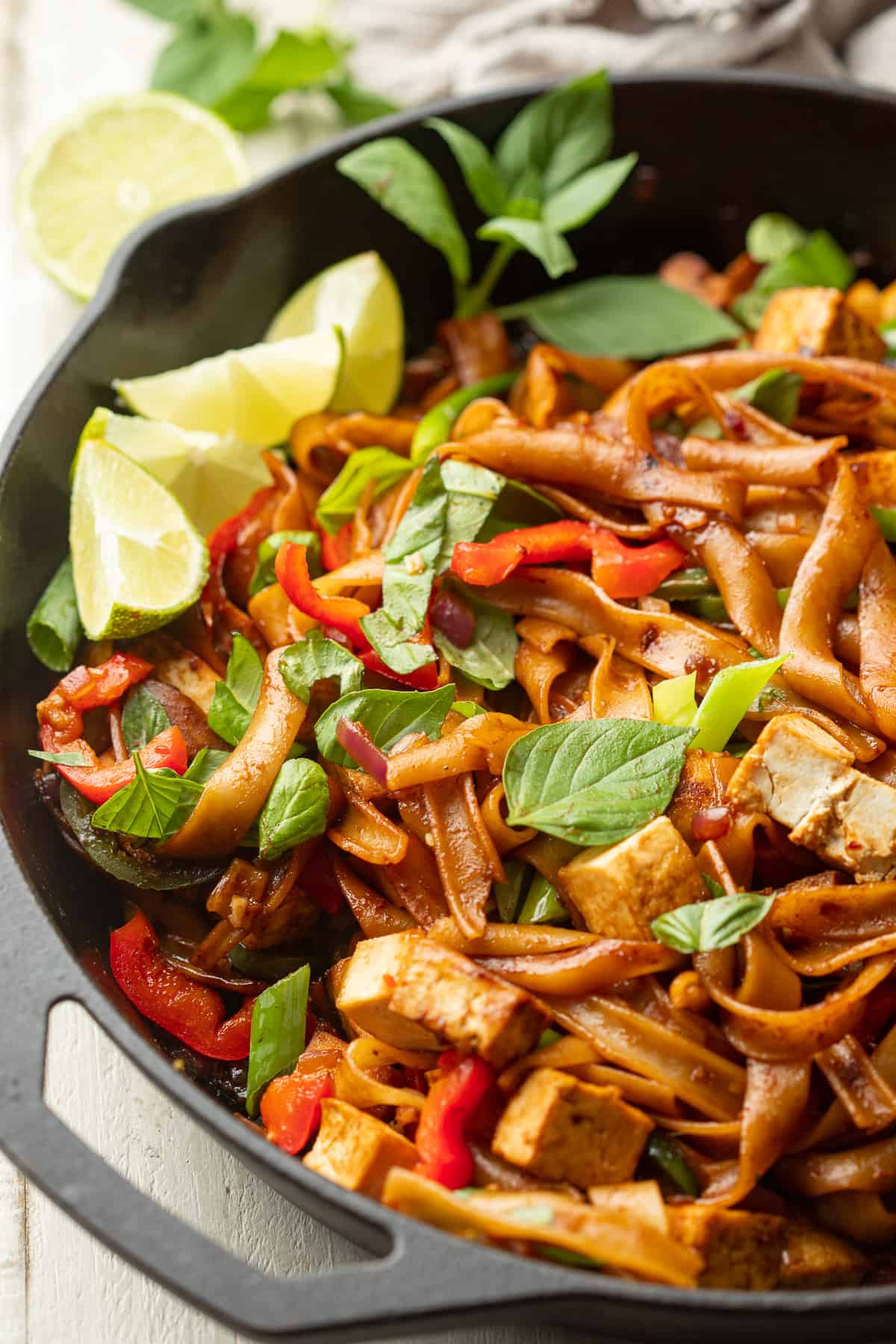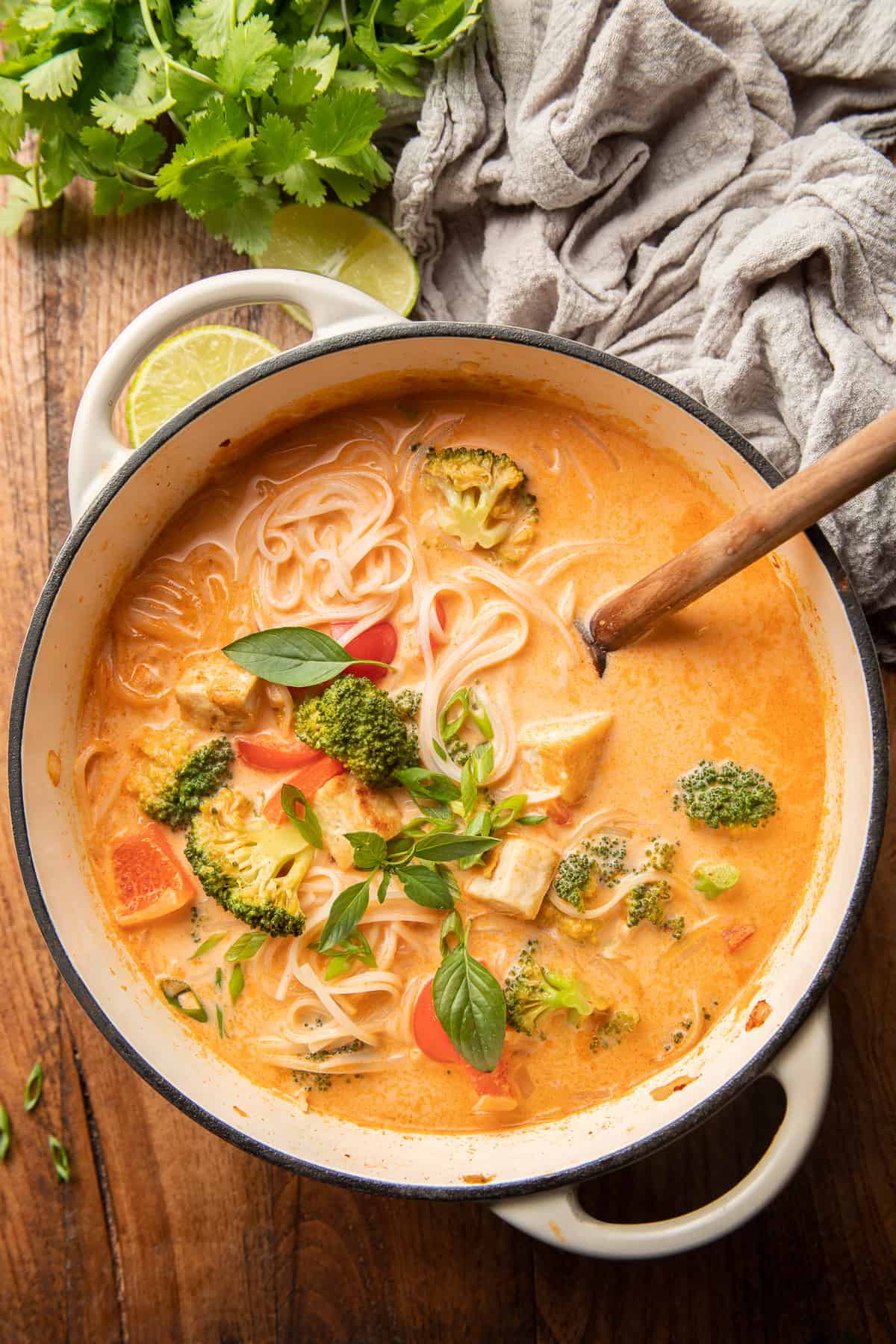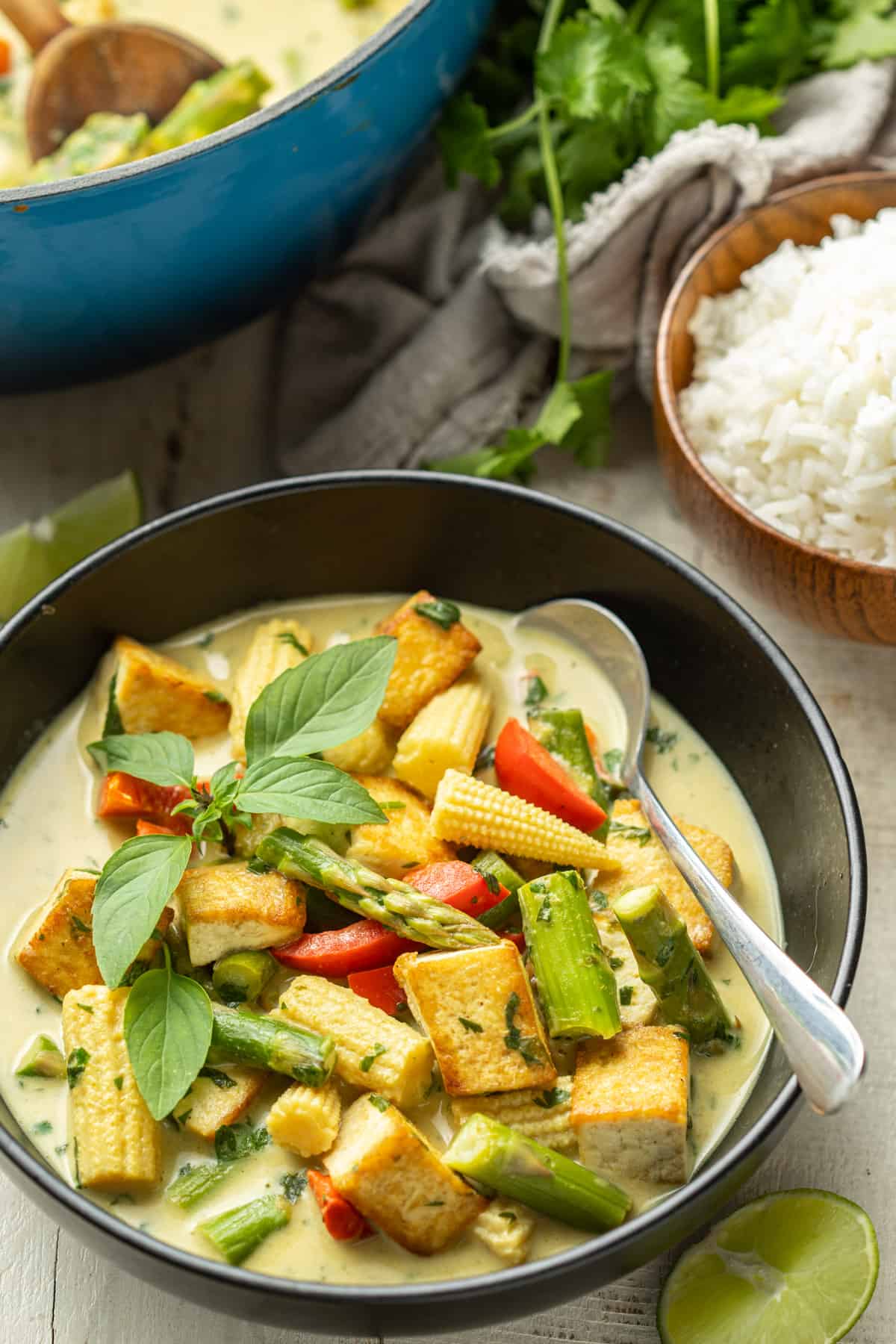Wondering if that Thai curry on the restaurant menu is vegan? Or what about those spring rolls? Read on to find out what your Thai dining options are as a vegan!

Many foods that you might assume are vegan, are in fact not. I’m sorry to say that I learned this the hard way! Before the internet provided all the answers I happily ordered Thai curries made with tofu and veggies, assuming any dish with tofu and veggies as the main ingredients must be vegan, right?
Nope!
While Thai cuisine is quite vegan-friendly, navigating a Thai menu or buying ingredients at the store can be confusing if you choose not to eat animal products. That’s because many of the foods that westerners associate with vegan cuisine are commonplace in all diets in Thailand — not just plant-based ones!
Never assume a dish is vegan just because it contains tofu.
So which Thai dishes and ingredients are vegan? What questions should you ask when ordering at a restaurant? And what ingredients should you look out for on product labels? We’ll cover it all in detail below!
Jump to:
Restaurant Dining
The first rule of dining out as a vegan is this: always ask if the dish is vegan. This may mean explaining what the term “vegan” means, or, to sound less condescending, asking if a specific ingredient is part of the dish.
Here are a examples:
- I don’t eat any animal products, including eggs, dairy, and honey. Does this dish include any of them?
- Is your red curry made with shrimp paste?
- Does this stir-fry have fish sauce in it?
- Is the soup made with any kind of meat broth, like chicken broth?
The only time I’ll order a dish without asking is when the menu specifically indicates that it’s vegan.
Vegan-Friendly Thai Dishes

Here are a few potentially vegan dishes to try, keeping in mind that you’ll want to double check with your server or look for an indication on the menu that it’s vegan.
Curries
Thai curry comes in many delicious flavors! Green curry is perfect if you love heat. Red curry is also pretty hot, but a touch sweeter than green. Yellow curry is mellow and mild. Massaman is perfect if you love peanuts and warming spices.
Any of these curries can be made vegan. They’re typically made with a coconut milk base, curry paste, veggies, and fresh herbs like Thai basil or cilantro. Often menus will give you the option of ordering a curry with tofu instead of meat.
The curry paste is usually the ingredient to look out for, as many of them are made with shrimp paste. In addition, some curries may be seasoned with fish sauce. It really depends on the chef’s preference, so be sure to ask!
Noodles
Thai cuisine includes many dishes made with rice noodles like pad Thai and pad kee mao (drunken noodles).
Look out for eggs in these dishes. Often they’ll be scrambled right in with the noodles, so you run the risk of accidentally taking a bite (or eating a whole plateful) of eggy noodles without even knowing it. The good news is that it’s easy to ask the cook to hold the eggs.
Lots of noodle dishes are seasoned with fish sauce, so ask about this as well. True story: I ate fish sauce for years without having any idea what it was. I thought it was some funky variety of soy sauce.
Always be super careful and never make assumptions.
Stir-Fries
Thai stir-fries are often loaded with delicious, vegan-friendly ingredients. You’ll find veggies such as potatoes, red bell pepper, broccoli, carrots and cabbage, as well as plant-proteins like tofu, usually served over jasmine rice.
But just like with noodle dishes, Thai-stir fries may be made with fish sauce, and occasionally eggs. Ask your server if any of these ingredients are included, and if so, whether substitutions can be made.
Appetizers
Thai cuisine includes a wide variety of appetizers, from finger foods like spring rolls and dumplings, to delicious soups and salads.
With such an array of foods, it can be tough to keep track of what ingredients to look out for, so always play it safe and ask.
Thai Cooking

Because Thai cuisine is so vegan-friendly, you’ll find lots of vegan recipes online and in cookbooks for the dishes mentioned above, and others! Be careful when buying ingredients though. Let’s talk about a few ingredients to watch out for or eliminate in order to keep your Thai home-cooking vegan.
Meat
Okay, so maybe this one is obvious. If a recipe calls for any kind of meat, including but not limited to chicken, fish, pork or beef, it’ll need to be modified.
One solution is to simply leave the meat out. Fortunately, many Thai recipes are so packed with other vegan-friendly ingredients like vegetables, rice and noodles, that they’ll be just as delicious and satisfying when made without meat.
Another solution is to replace the meat. Plant-based proteins excellent stand-ins for meat in pretty much any cuisine, Thai included!
Tofu is one of the most logical choices for replacing meat in Thai recipes, because it’s an ingredient that’s already present in lots of Thai dishes. Fried tofu, smoked tofu, baked tofu, or pan-fried tofu can easily be added to a stir-fry or curry that would normally include meat.
Seitan is an excellent plant-protein that actually looks and tastes like meat. Seitan can be bought in most supermarkets, and homemade seitan is surprisingly easy to make.
Tempeh is an Indonesian soy product, which, while not necessarily authentic to Thai cuisine, still works really well as a vegan protein element, particularly in stir-fries.
Eggs
You’ll find eggs in lots of Thai recipes, particularly fried rice and noodle-based dishes. Eggs can usually be omitted, but if you feel like the dish will be missing something, try one of the plant-based protein options mentioned above.
One creative solution for replacing eggs in Thai dishes is to scramble up some tofu, similarly to how you would with eggs, optionally seasoning it with a pinch of kala namak for eggy flavor and turmeric for color.
Curry Paste
Watch out when buying curry paste, since lots of brands are made with shrimp paste.
One way to avoid this issue is by making your own curry paste. Check out my recipes for vegan red curry paste and vegan green curry paste.
You also have lots of options for vegan store-bought curry pastes.
- Thai Kitchen. Thai Kitchen brand curry pastes are vegan and gluten-free. They’re available in red and green varieties and available at most supermarkets. I find them to be much milder than what you’d get at a restaurant, but that may be a good thing if you’re sensitive to heat.
- Maesri. I’m starting to see this brand pop up in stores, but it’s also widely available online. It’s my preferred brand of curry paste and the one used to develop most of my Thai curry recipes.
- Other brands. You should find many brands of curry paste at Asian markets, and some of them just might be vegan, so check the label!
Fish Sauce
If you come across fish sauce in a Thai recipe, you’ll probably need to replace it with something. The dish will taste bland if you don’t.
Soy sauce is usually the simplest choice. It has a somewhat similar, salty, fermented flavor to fish sauce. Since the flavors and degrees of saltiness vary, I don’t recommend simply throwing soy sauce into a recipe where fish sauce is called for. Proceed with caution, taste-testing, adding a bit at a time if at all possible. When in doubt, go light on the soy sauce and add more at the table.
Liquid aminos and tamari can both be used similarly to soy sauce.
Vegan fish sauce is another option. While it may not taste exactly like non-vegan fish sauce, it generally does the job of replacing it in recipes. Store-bought vegan fish sauce is a thing, or you can try whipping up some homemade vegan fish sauce.
Vegan Thai Recipes to Try
Like this post? Let me know in the comments! Also be sure to follow me on Facebook, Pinterest or Instagram, or subscribe to my newsletter for more tips!

